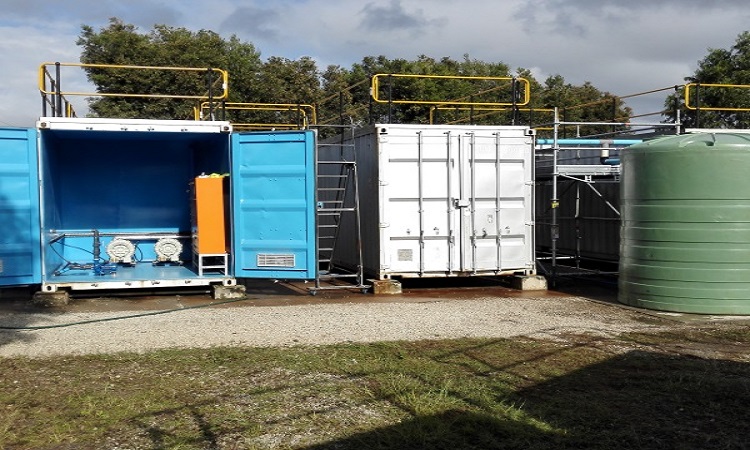Containerized Effluent Treatment Plant

Containerized Effluent Treatment Plant Process
A containerized effluent treatment plant is a compact and self-contained wastewater treatment system that is housed within a shipping container. These plants are designed to treat industrial, municipal, or other types of wastewater in a portable and convenient manner. Containerized effluent treatment plants offer several advantages, including mobility, ease of installation, and versatility.
1. Pre-Treatment
Screening: The initial step in the pre-treatment stage involves removing large solids and debris from the wastewater. Mechanical screens are used to filter out items such as plastics, rags, and other large particles, which could damage downstream equipment.
Grit Removal: After screening, grit removal units eliminate sand, gravel, and other small, dense particles that can cause abrasion and blockages in the treatment system.
Equalization: The equalization tank balances the flow and load of the incoming wastewater, ensuring a consistent and steady flow to the subsequent treatment stages. This helps to prevent sudden surges that could disrupt the treatment process.
2. Primary Treatment
Sedimentation or Flotation: In this stage, the wastewater undergoes sedimentation or flotation to remove suspended solids. During sedimentation, heavier particles settle at the bottom of a tank, forming sludge. In flotation, air bubbles introduce, causing lighter solids to float to the surface for removal. This significantly reduces the solid content in the wastewater.
Related Topic: Why Effluent Treatment Plant is Important for Industries?
3. Secondary Treatment
Biological Treatment: The secondary treatment focuses on the biological degradation of organic matter. Common methods include activated sludge processes or biofilm reactors. In an activated sludge system, microorganisms consume organic pollutants, converting them into biomass, water, and carbon dioxide. Biofilm reactors, on the other hand, use surfaces where biofilms (microbial colonies) grow and treat the wastewater as it flows over them.
Secondary Clarification: After biological treatment, the mixture of treated water and biomass is sent to a secondary clarifier. Here, the biomass (sludge) settles, and the clarified effluent moves on to the next stage. The settled sludge is either returned to the biological treatment stage or sent for further processing.
4. Tertiary Treatment
Filtration: In the tertiary treatment stage, advanced filtration methods used to remove any remaining fine particles from the effluent. Common filtration techniques include sand filters, membrane filters, or activated carbon filters.
Disinfection: To ensure that the effluent is free from harmful pathogens, disinfection methods such as chlorination, ultraviolet (UV) treatment, or ozonation are employed.
Nutrient Removal: Some ETPs also include processes for the removal of nutrients such as nitrogen and phosphorus, which can contribute to eutrophication in receiving water bodies.
5. Sludge Management
Sludge Treatment and Disposal: The sludge generate during the primary and secondary treatment stages is further treat to reduce its volume and stabilize it. Methods include thickening, anaerobic digestion, and dewatering. The treated sludge is then dispose of safely, often use as fertilizer or incinerated.
Related Topic: Importance of Effluent Treatment Plants for Hospitals
Benefits of a Containerized Effluent Treatment Plant
The Containerized Effluent Treatment Plant (CETP) in Gurgaon, India is revolutionizing wastewater treatment. The CETP is a first-of-its-kind plant that treats effluent from industries using an advanced membrane bioreactor technology. This state-of-the-art technology enables the CETP to achieve high levels of removal of pollutants, including dissolved organics, suspended solids, and heavy metals. The treated effluent meets or exceeds the most stringent discharge standards set by the Central Pollution Control Board (CPCB).
The benefits of the CETP are many. First, it significantly reduces environmental pollution. Second, it decreases the load on the existing wastewater treatment infrastructure in Gurgaon, which is already under strain due to rapid urbanization and industrialization. Third, it provides a cost-effective solution for treating effluent from industries. It generates renewable energy in the form of methane gas, which can be using to power the plant itself. It creates jobs for local people in the operation and maintenance of the plant.
Challenges Faced by the CETP
The CETP in Gurgaon faces several challenges, including:
– Ensuring an uninterrupted supply of treated effluent to industries
– Managing the wastewater generated by industries
– Maintaining the quality of treated effluent discharged into the environment
– Reducing the overall cost of wastewater treatment
Conclusion
Containerized Effluent Treatment Plants represent a highly effective solution for wastewater treatment in diverse settings. Their compact, self-contained design, housed within shipping containers, makes them exceptionally versatile and easy to deploy. These plants not only ensure efficient treatment of industrial, municipal, or other types of wastewater but also offer mobility and straightforward installation. With their ability to meet environmental discharge standards and adapt to varying operational needs,
Related Topic: Top 5 Effluent Treatment Plant Manufacturers in India